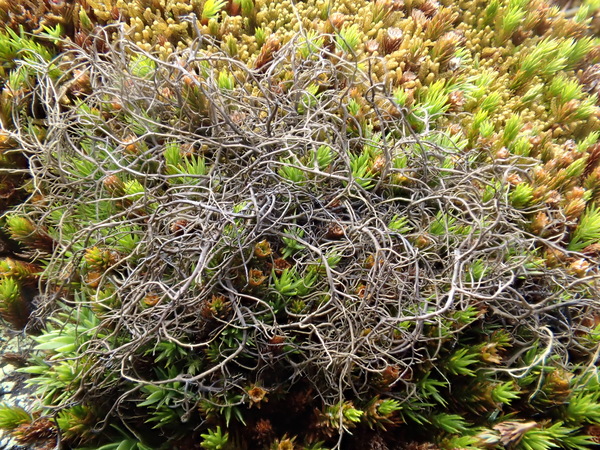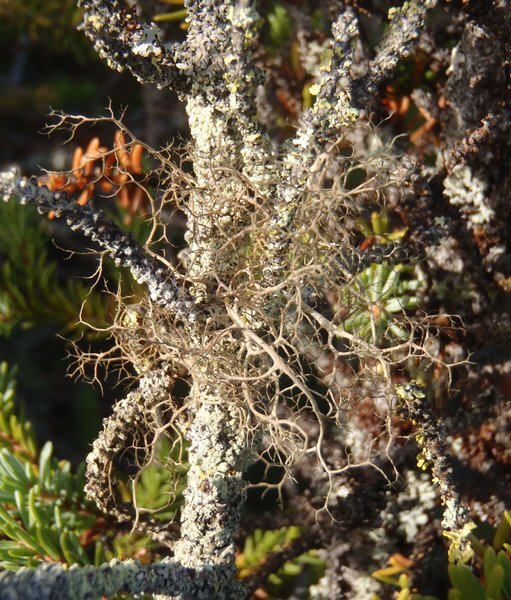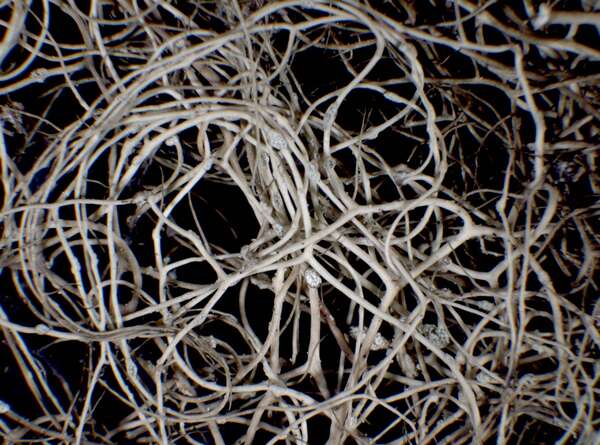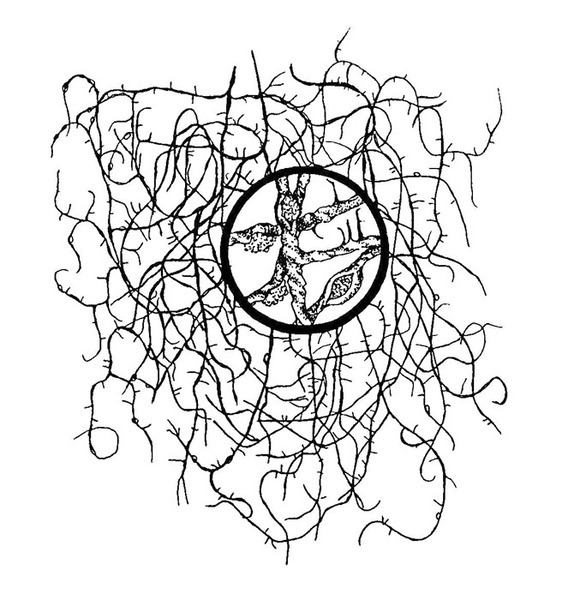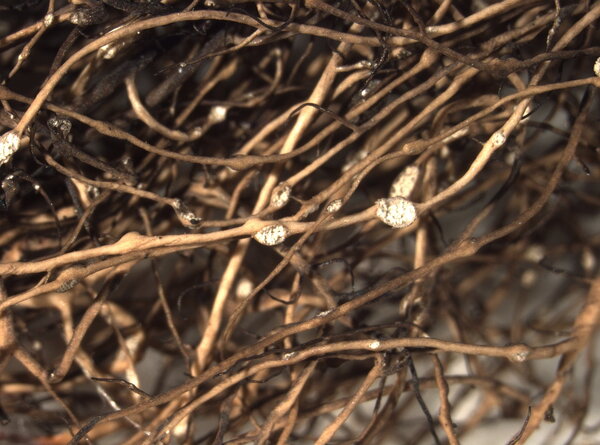Bryoria nadvornikiana (Gyeln.) Brodo & D. Hawksw.
Opera Bot., 42: 122, 1977. Basionym: Alectoria nadvornikiana Gyeln. - Acta Fauna Fl. Univ., ser. 2, 1: 6, 1932.
Synonyms: Alectoria altaica (Gyeln.) Räsänen; Alectoria implexa var. nadvornikiana (Gyeln.) Zahlbr.; Alectoria spinulosa Ahlner nom. nud.
Description: Thallus fruticose, tufted in basal parts, pendent in the apical parts, attached by a basal holdfast, to 20 cm long, pale grey to pale brown, usually with a pink hue, rarely dark brown in sun-exposed morphs, isotomic-dichotomously branching with obtuse (towards the base) to acute angles, the main branches mostly terete, often with sparse to abundant lateral spinules. Soralia sparse to usually abundant, small, tuberculate, white to greenish white, with farinose soredia. Pseudocyphellae sparse, inconspicuous, or usually absent; medulla white, compact. Apothecia extremely rare, zeorine, with a brown disc, to 2 mm across. Asci 8-spored, Lecanora-type. Ascospores 1-celled, hyaline, subglobose to ellipsoid, 5-7 x 3-4 μm. Photobiont chlorococcoid. Spot tests: cortex and medulla K+ yellow, C+ red, KC+ red, P+ yellow; soralia P+ red. Chemistry: alectorialic and barbatolic acids, sometimes atranorin; fumarprotocetraric acid in soralia.
Growth form: Fruticose filamentous
Substrata: bark
Photobiont: green algae other than Trentepohlia
Reproductive strategy: mainly asexual, by soredia, or soredia-like structures (e.g. blastidia)
Commonnes-rarity: (info)
Alpine belt: absent
Subalpine belt: rather rare
Montane belt: very rare
Dry submediterranean belt: absent
Humid submediterranean belt: absent
Padanian area: absent
pH of the substrata:
1 2 3 4 5
Solar irradiation:
1 2 3 4 5
Aridity:
1 2 3 4 5
Eutrophication:
1 2 3 4 5
Poleotolerance:
0 1 2 3
Altitudinal distribution:
1 2 3 4 5 6
Rarity
absent
extremely rare
very rare
rare
rather rare
rather common
common
very common
extremely common
Loading data...
Occurrence data
Predictive map
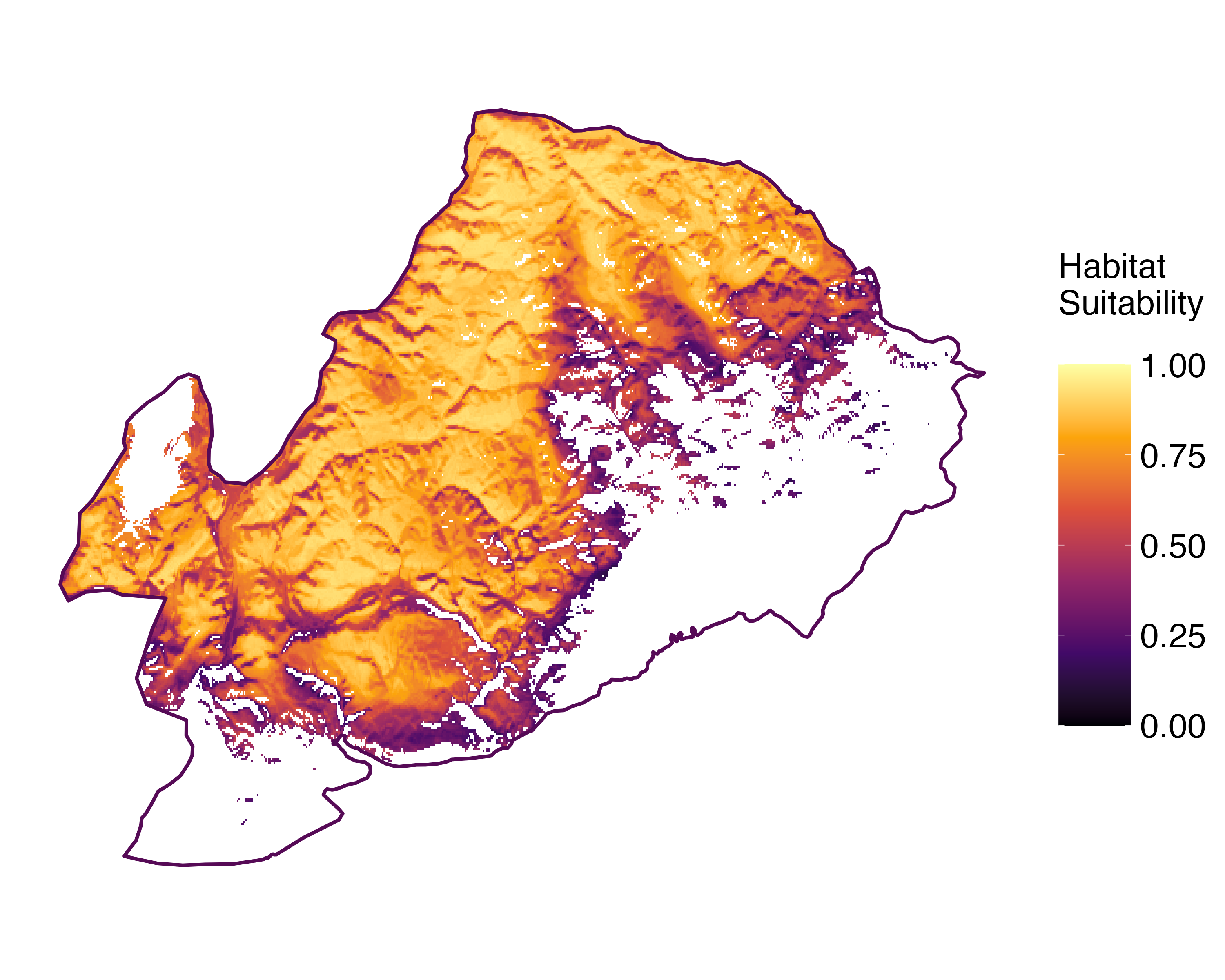 Current prediction (1981-2010)
Current prediction (1981-2010) Future prediction (2071-2100) SSP 1-2.6
Future prediction (2071-2100) SSP 1-2.6 Future prediction (2071-2100) SSP 5-8.5Predictive maps according to Francesconi et al. 2025
Future prediction (2071-2100) SSP 5-8.5Predictive maps according to Francesconi et al. 2025
Growth form: Fruticose filamentous
Substrata: bark
Photobiont: green algae other than Trentepohlia
Reproductive strategy: mainly asexual, by soredia, or soredia-like structures (e.g. blastidia)
Commonnes-rarity: (info)
Alpine belt: absent
Subalpine belt: rather rare
Montane belt: very rare
Dry submediterranean belt: absent
Humid submediterranean belt: absent
Padanian area: absent
pH of the substrata:
| 1 | 2 | 3 | 4 | 5 |
Solar irradiation:
| 1 | 2 | 3 | 4 | 5 |
Aridity:
| 1 | 2 | 3 | 4 | 5 |
Eutrophication:
| 1 | 2 | 3 | 4 | 5 |
Poleotolerance:
| 0 | 1 | 2 | 3 |
Altitudinal distribution:
| 1 | 2 | 3 | 4 | 5 | 6 |
Rarity
absent
extremely rare
very rare
rare
rather rare
rather common
common
very common
extremely common
Loading data...
Occurrence data
Predictive map
 Current prediction (1981-2010)
Current prediction (1981-2010) Future prediction (2071-2100) SSP 1-2.6
Future prediction (2071-2100) SSP 1-2.6 Future prediction (2071-2100) SSP 5-8.5
Future prediction (2071-2100) SSP 5-8.5Predictive maps according to Francesconi et al. 2025


